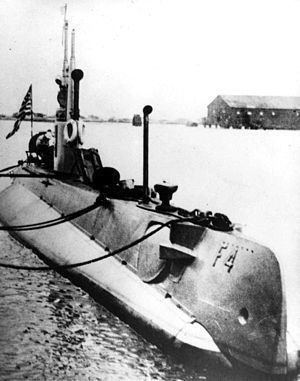Name USS F-4 Struck 31 August 1915 Length 43 m Builder Seattle | Commissioned 3 May 1913 Launched 6 January 1912 Beam 4.7 m | |
 | ||
Laid down 21 August 1909, as USS Skate Renamed USS F-4, 17 November 1911 Fate Foundered, 25 March 1915
Raised, 29 August 1915; later a harbor marker and buried as trench fill off Pearl Harbor, 1940 | ||
USS F-4 (SS-23) was a United States Navy F-class submarine. Her keel was laid down by the Moran Brothers of Seattle, Washington. She was originally named Skate, making her the first ship of the United States Navy named for the skate. She was renamed F-4 on 17 November 1911. She was launched on 6 January 1912 sponsored by Mrs. M.F. Backus; and commissioned on 3 May 1913 with Lieutenant (junior grade) K.H. Donavin in command.
Service history
Joining the First Submarine Group, Pacific Torpedo Flotilla, F-4 participated in the development operations of that group along the west coast, and from August 1914, in Hawaiian waters. During submarine maneuvers off Honolulu, Hawaii on 25 March 1915, she sank at a depth of 306 ft (93 m), 1.5 mi (2.4 km) from the harbor. Despite valorous efforts of naval authorities at Honolulu to locate the missing boat and save her crew, all 21 perished (C.O. LT(jg) Alfred Louis Ede and crew). F-4 was the first commissioned submarine of the U.S. Navy to be lost at sea.
A diving and engineering precedent was established with the Navy's raising of the submarine on 29 August 1915. Courage and tenacity marked the efforts of divers who descended to attach cables to tow the boat into shallow water, while ingenuity and engineering skill characterized the direction of Naval Constructor J.A. Furer, Rear Admiral C.B.T. Moore, and Lieutenant C. Smith who accomplished the feat with the aid of specially devised and constructed pontoons. Navy diver George D Stillson found the superstructure caved in and the hull filled with water. One of the divers involved in the salvage operation was John Henry Turpin, who was, probably, the first African-American to qualify as a U.S. Navy Master Diver. Only four of the dead could be identified; the 17 others were buried in Arlington National Cemetery.
The investigating board subsequently conjectured that corrosion of the lead lining of the battery tank had permitted seepage of sea water into the battery compartment and thereby caused the commanding officer to lose control on a submerged run. Others believe that the bypassing of an unreliable magnetic reducer closed a Kingston valve in the forward ballast tank resulting in a delay. Based on other reported issues, there may also have been problems with the air lines supplying the ballast tank.
F-4 was stricken from the Naval Vessel Register on 31 August 1915.
In 1940, the remains of F-4 were buried as fill in a trench off the Submarine Base, Pearl Harbor.
